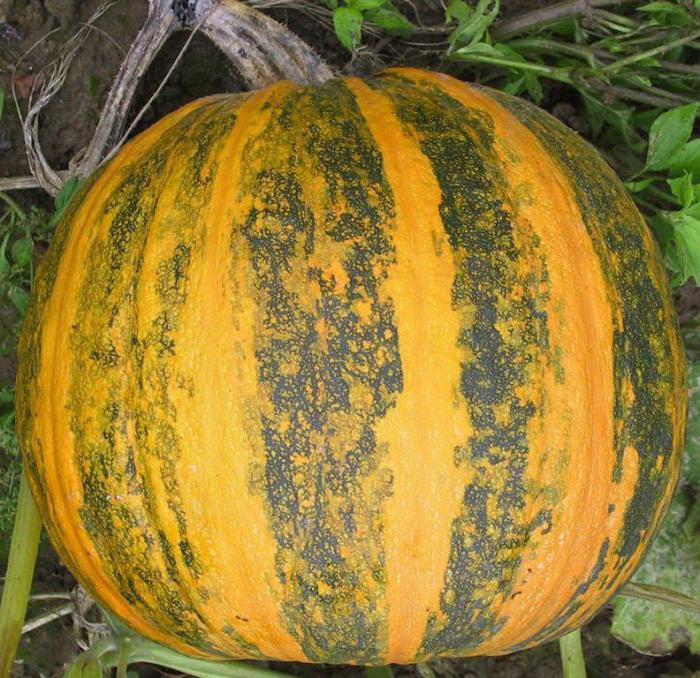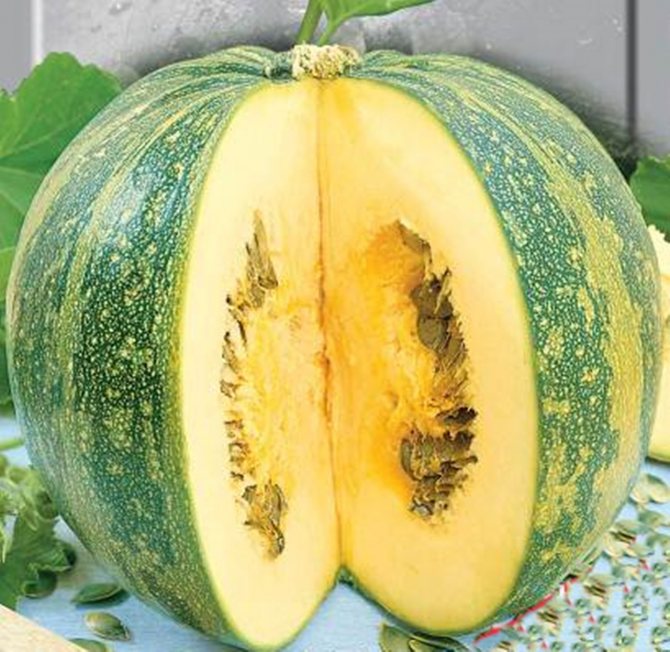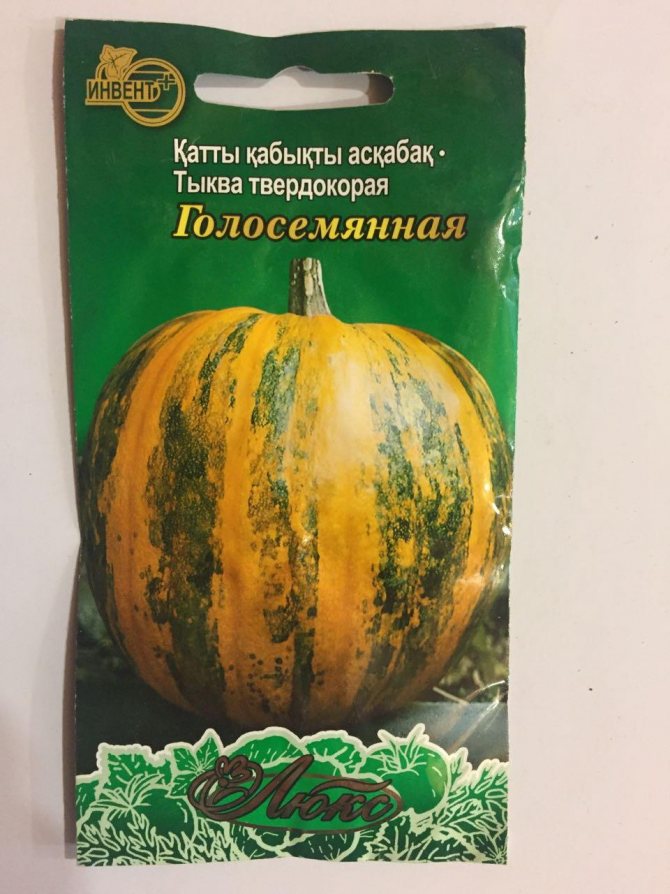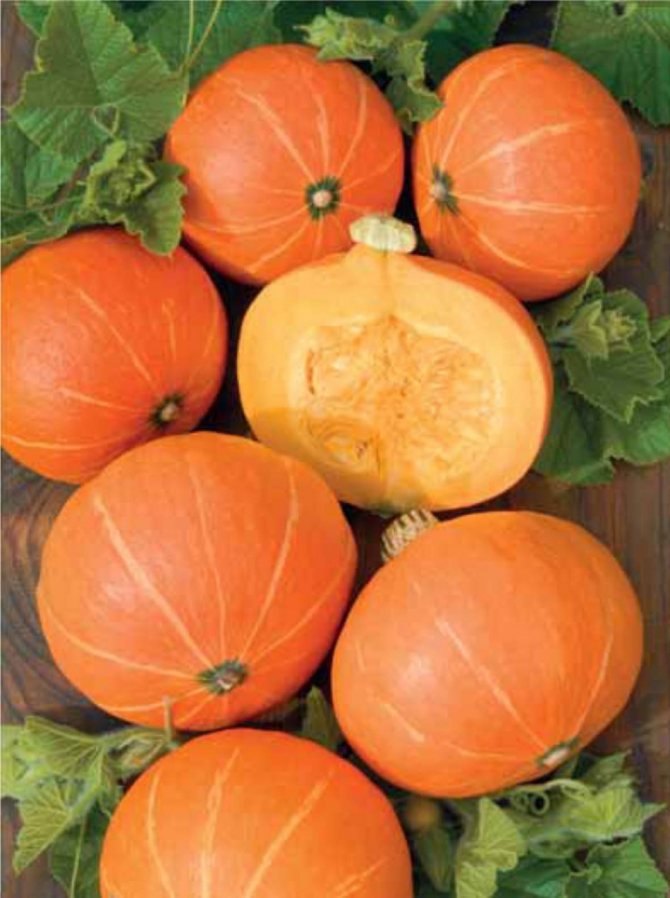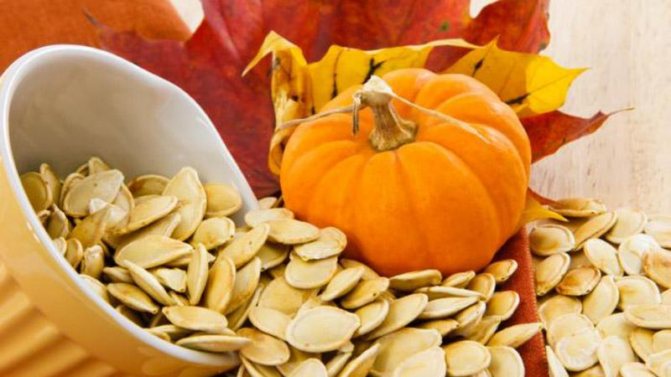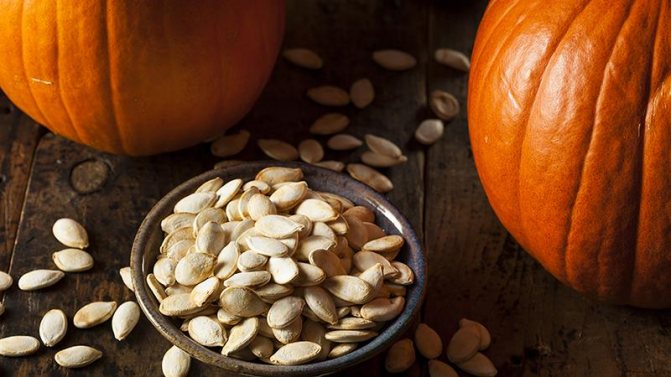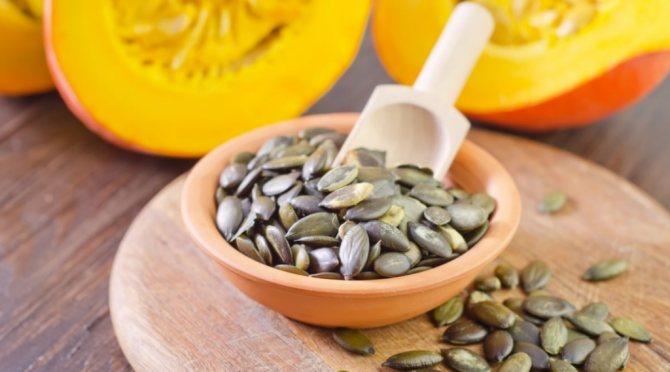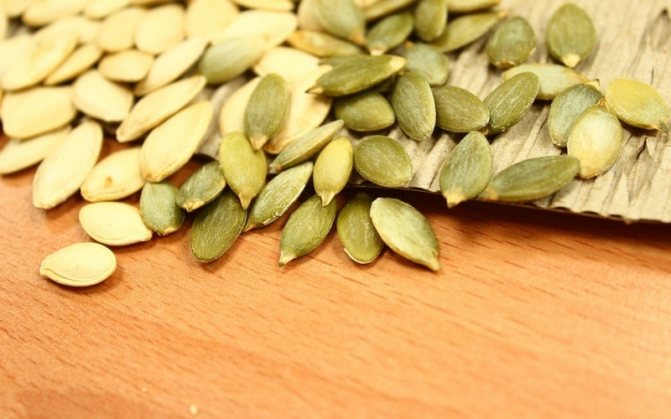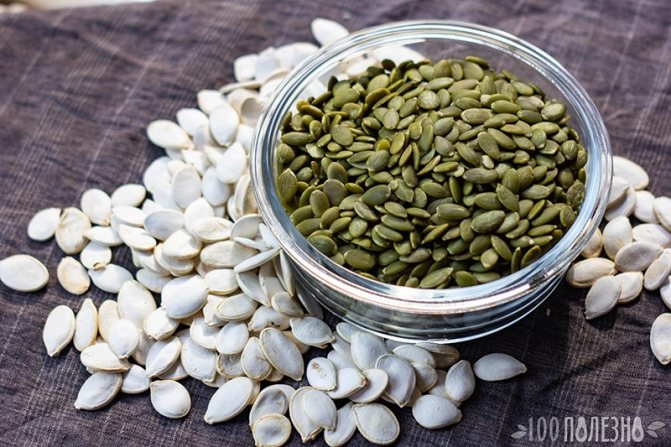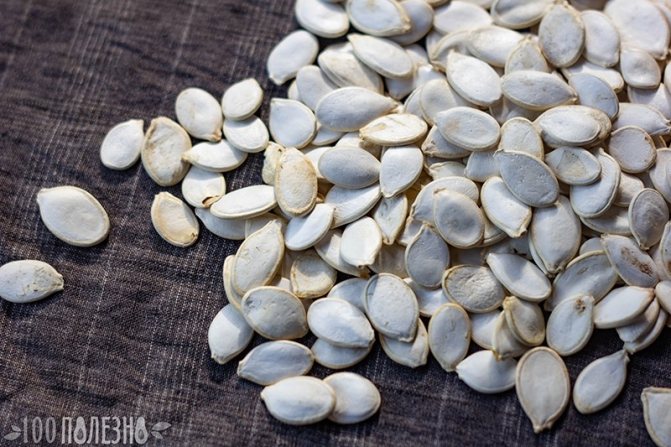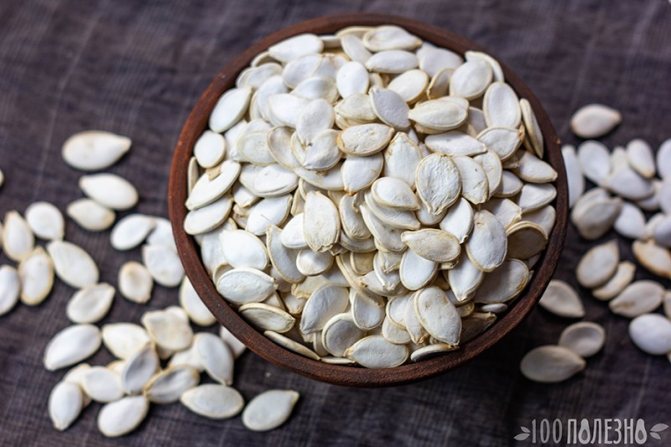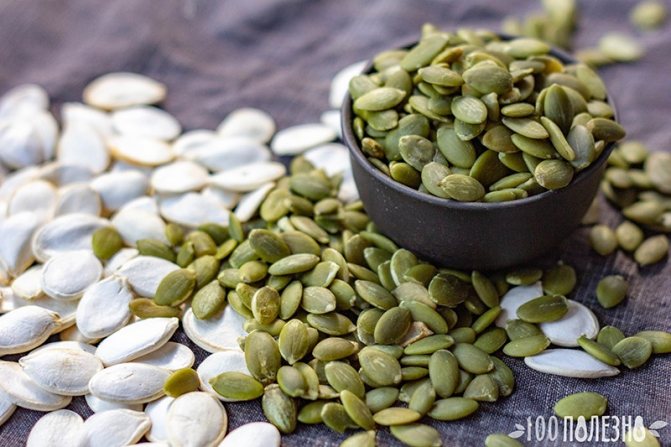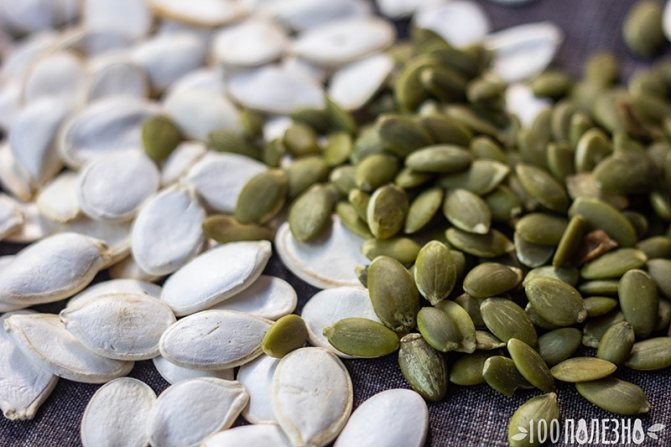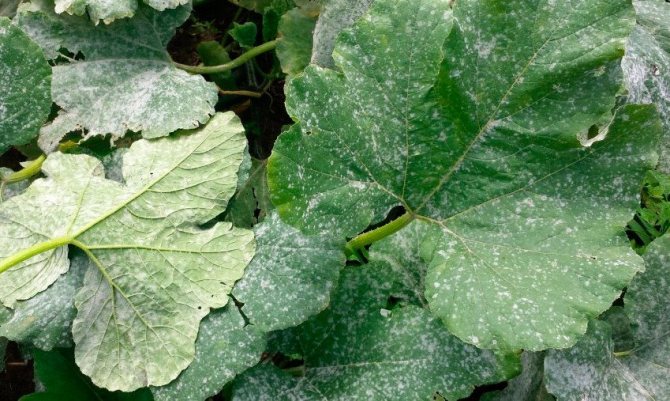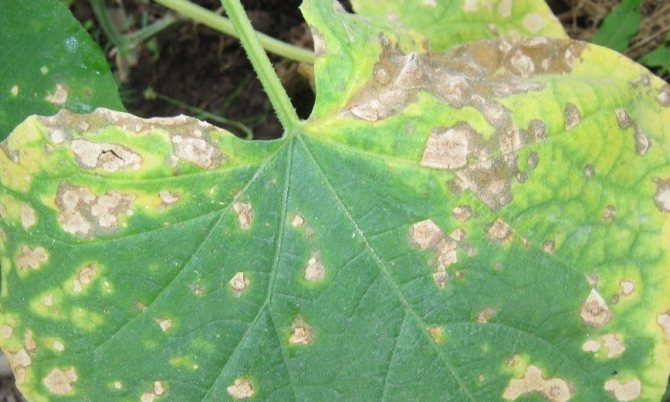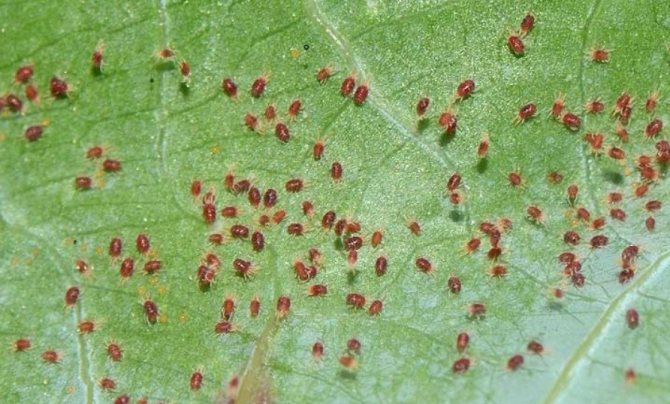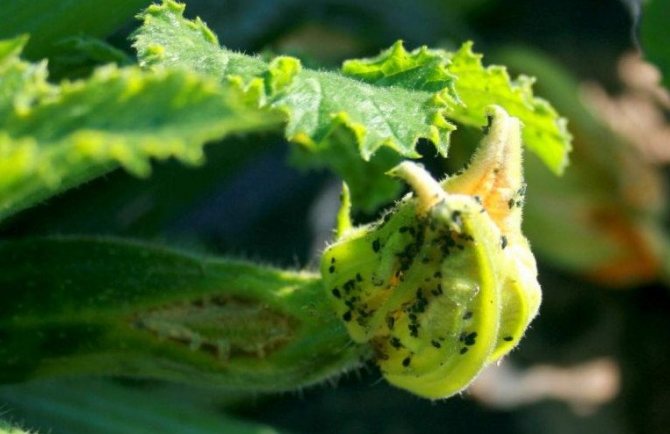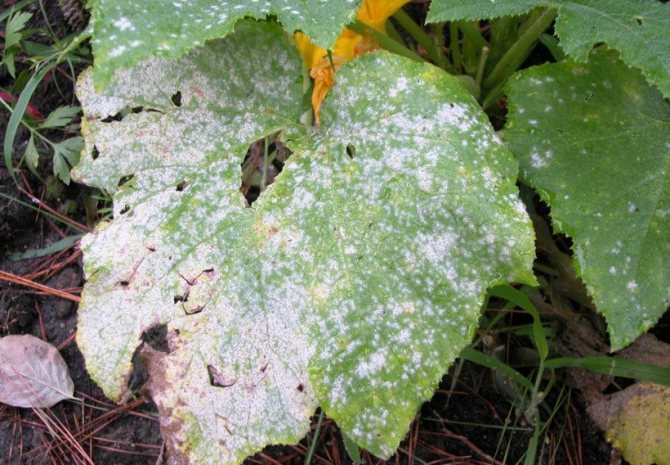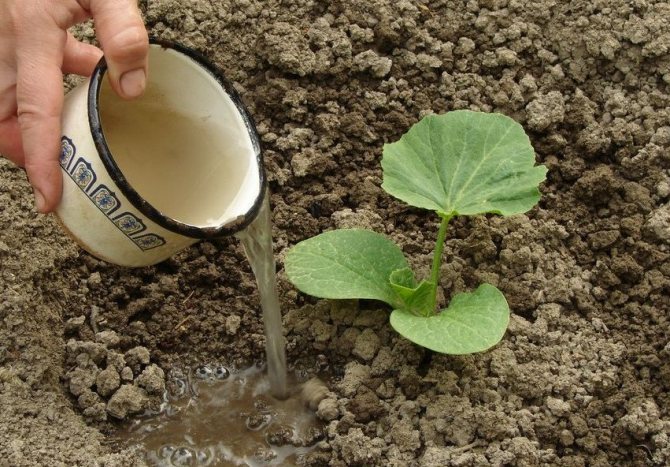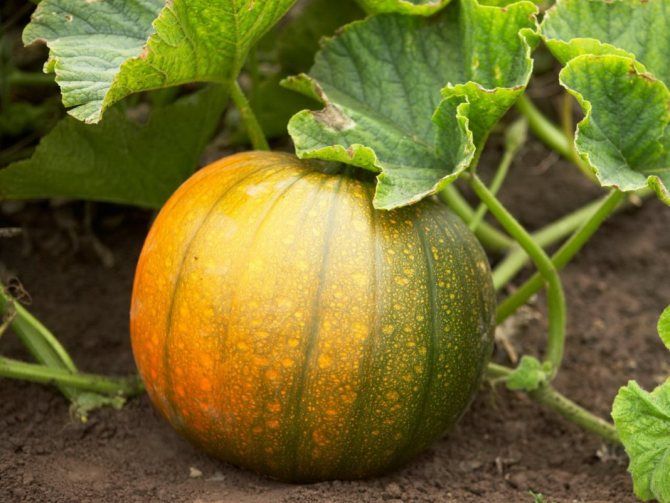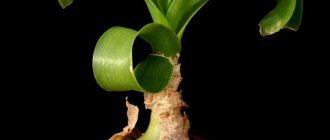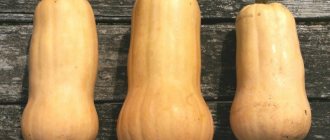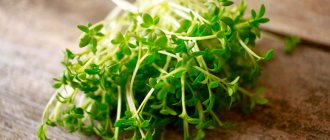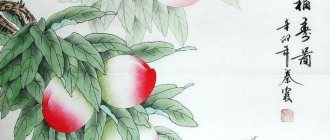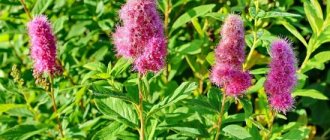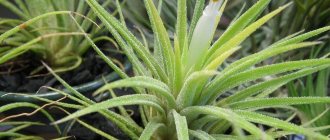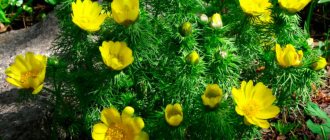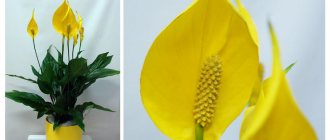Once I heard, now I don’t remember where or from whom, that there is a gymnosperm pumpkin. I really wanted to see with my own eyes if the seeds do not have a peel? But only five years ago I saw on sale naked seeds, without a peel. But this variety, gymnospermous pumpkin, was bred a very long time ago - at the beginning of the last century. I was looking forward to the first harvest. But planting gymnosperm seeds in open ground ended in failure. It was later that I learned that there are some peculiarities of growing pumpkin with bare seeds without a peel.
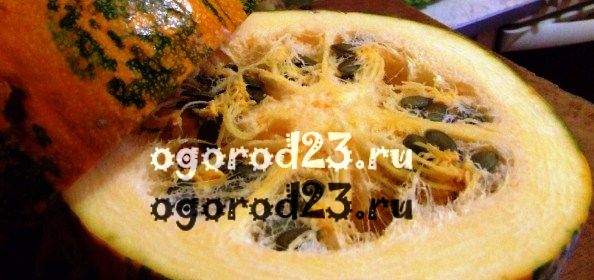
In fact, I did not see any special external differences from an ordinary pumpkin. Well, except that her flowers are larger.
Gymnospermous pumpkin: full characteristics
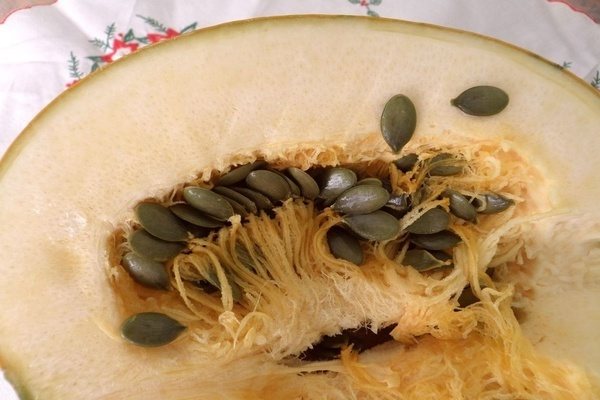

From the point of view of visual appearance, such a pumpkin does not differ from an ordinary one. Gymnosperms pumpkin belongs to herbaceous plants. The plant grows quickly enough, in the period from two to four months so many shoots can form that an area of about thirty meters will be completely covered. Such pumpkin comes in different varieties, which differ in their shape and color. Growing conditions are the same as for ordinary pumpkin.
If we talk about the biological properties of such a pumpkin, then again they do not differ from the usual one. Gymnospermous pumpkin shows higher requirements to the temperature regime of the soil at the time of planting the plant in the soil. Since the seeds of such a pumpkin are not protected by any shells, they begin to lay faster. However, if the soil temperature is lower than +17 degrees, it means that the sprouts will not survive. Many experienced gardeners prefer to sow common pumpkin seeds directly into the open ground. As for the gymnospermous pumpkin, the seedling method is preferable for it.
As a rule, gymnospermous pumpkin is not large-fruited, usually one fruit in weight reaches about six to eight kilograms. Flowers of such a pumpkin variety are given in larger quantities than ordinary pumpkin varieties. In addition, they are larger in size. Let's move on to characteristics gymnosperms pumpkins:
- The stems of this plant have voids, in their length they reach about eight meters, quite powerful. The scourges have a light greenish color, have ribbing in texture, slightly pubescent. The antennae of the plant are rather elongated, with an average size.
- These plants have a fairly large number of leaves. The leaf has a rounded shape, they are weakly dissected. The texture is uniform, with thick veins. The leaf is dark green in color. The surface has a small fluff.
- As a rule, one plant is capable of forming about seventy female flowers, and about three hundred and fifty male flowers. At the same time, men are formed first. Flowers are arranged singly, have a bright yellow color.
- As for the shape of the pumpkin itself, as well as its weight, these parameters are highly dependent on the variety. Typically, the fruit is round and orange in color with dark greenish stripes that run vertically.
- The seeds of these pumpkins are medium in size. Above, they have a thin dark film of a greenish tint. Quite a lot of them are formed.
All gymnosperms are monoecious and require insects to pollinate the plants.If there are no problems with this, then the chance of achieving good yields will be much higher.
The nutritional value


The pulp of the gymnosperm does not have a pronounced taste. Some of its varieties, such as Apricot, Belorusskaya, have a high sugar content, so they are often used to make cereals, mashed potatoes, juice.
Gymnosperms are valuable as seeds. Their uniqueness lies in the absence of the usual hard shell. Their scope of application is quite wide:
- seeds are used to make pumpkin seed oil, the benefits of which are beyond doubt: it is eaten, used in cosmetology;
- confectioners and cooks use fried and ground seeds as a seasoning for desserts, salads, main dishes, sauces;
- the high content of vitamins A and E (antioxidants) allows the use of the oil from them for the treatment of certain diseases.
Gymnospermous pumpkin: the benefits and harms of seeds and fruits
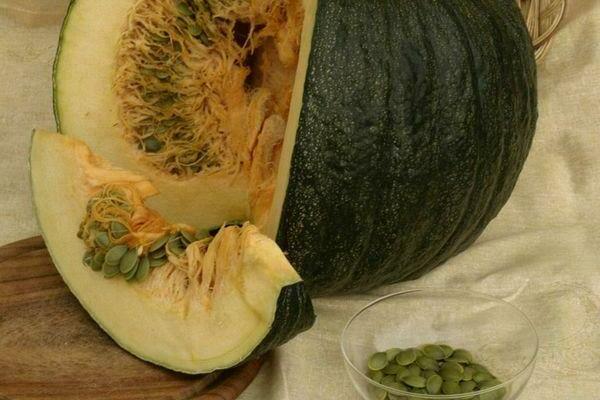

Gymnospermous pumpkin: a description of the pros and cons of using
The chemical composition of this culture is quite rich in substances useful for the human body. For this reason, these fruits are often used for medicinal purposes, as well as in pharmacology. The pulp of gymnosperms contains as many useful elements as ordinary pumpkins. The seeds, in turn, help fight helminths.
The distance between the seed and the surface coating is occupied by a kind of film, which in its composition contains a useful substance called cucurbitin. It should be noted that gymnospermous pumpkin has more such substance than ordinary pumpkin.
Regular consumption of pumpkin in food helps metabolism to be carried out well, gives the body strength. The chemical composition of pumpkin has a good effect on the functioning of the gastrointestinal tract, as well as on the state of hemoglobin. And pumpkin contains a fairly large amount of choline, this substance has a beneficial effect on the liver, helps to restore the affected areas.
Thanks to zinc and phosphorus, which are also found in pumpkin fruits, blood vessels become more elastic. Zinc helps produce estrogen as well as testosterone. Also, the benefit of gymnospermous pumpkin is that it contains calcium, which has a good effect on human bone tissue. The composition of pumpkin improves brain activity and also has a beneficial effect on the functioning of the bladder and kidneys. And pumpkin has such an important element for humans as iron. It takes part in blood circulation. Regular inclusion of pumpkin in your diet will help get rid of skin problems. In addition, the fruits help fight a variety of parasites that can form in humans in the body.
However, almost any fruit, even a very useful one, has a number of restrictions on its use. So, for example, people suffering from dysbiosis should use pumpkin with caution. Quite rarely, but sometimes pumpkin can cause allergies. People with diabetes should not eat too much pumpkin seeds. The same applies to those who have a disturbed acid-base balance. If you have an exacerbation of stomach ulcers, then it is best to refuse to use pumpkin.
Beneficial features
How is gymnosperm pumpkin useful from a medical point of view? Its merits are very difficult to overestimate. It is renowned for its dietary properties. The pulp of gymnosperms contains:
- sugar - 4-11%, with glucose being 2.6%;
- fiber, protein, starch, pectin;
- vitamins of group B, carotene, E, C, PP;
- macronutrients: magnesium, phosphorus, calcium, potassium, silicon, sodium;
- trace elements: iodine, cobalt, iron, zinc, fluorine, copper.
Pumpkin leaves contain significantly more vitamin C than pulp. And pumpkin seeds contain the following nutrients:
- fatty oil - up to 50%;
- protein - 28%;
- vitamins B1, C;
- phytosterols;
- carotenoids;
In gymnosperms, seeds, young shoots and pulp can be used for medicinal purposes. Due to the low calorie content, gymnosperm pumpkin, reviews of which are heard by people prone to overweight, is suitable for cooking on fasting days. They need to eat one and a half kilograms of oven-baked or boiled pumpkin. The high content of pectin in pumpkin has an excellent effect on patients with inflammatory processes in the large intestine. In addition, pectins promote the removal of harmful cholesterol from the human body and prevent its absorption.
Eating pumpkin:
- promotes the excretion of chlorine by the kidneys, therefore it is very useful for patients suffering from edema with heart disease;
- recommended for patients with poor kidney and liver function;
- helps people with gout.
The main property of pumpkin seeds for medicine is their anthelmintic effect. They promote the expulsion of round and tapeworms and are taken for prophylactic purposes. Gymnosperm pumpkin has a particularly strong effect. Reviews on the use of seeds prove the great benefits of this product.


Growing gymnosperms pumpkin is not much different from other hard-bore crops. It should be noted that it is more thermophilic, therefore, it should be planted in a warm ground and, preferably, in a seedling way. Otherwise, seeds that do not have a shell may simply rot. Many gardeners like gymnosperm pumpkin to taste. Reviews of delicious pulp and seeds that do not need to be peeled are quickly spreading among amateur gardeners.
Home comfort Beet "boyarynya": reviews, description, features of care and cultivation
Beetroot is everyone's favorite vegetable, from which you can prepare delicious dishes and healthy salads. Today, it can be found on the site of almost every gardener. There are many varieties. The review will consider ...
Home comfort Curly strawberry: reviews, care features and yield
Both in summer and in winter, strawberries are the most favorite berry for each of us. It is difficult to imagine that someone does not like this delicacy or its wild variety - strawberries. For a long time, people have been brewing delicious and useful ones from them ...
Home comfort Honey apples: description, varieties, features of care and cultivation
The apple is one of the few fruits with a wide variety of flavors. Varieties differ in terms of ripening, fruit hardness. And there is no need to talk about taste. A variety of flavors make with ...
Home comfort Types and varieties of daylilies: description, features of care and cultivation
Despite the frank similarity in names, lilies and daylilies, the description of the varieties of which is presented later in the article, have little in common, except for the external structure of the flower. These are large herbaceous plants with powerful cords ...
Home comfort Apple berry: features of care and cultivation
Among fruit ornamental crops, the berry (Siberian) apple tree, a representative of the Pink family, is very popular. Its place of origin is China. In Russia, in vivo ...
Home comfort Aloe: reproduction at home, features of care and cultivation
One of the most popular indoor plants, aloe, belongs to the lily family, a group of succulents. Its main distinguishing feature is long, fleshy leaves covered with soft thorns. Grows ...
Home comfort Potted flower: description, types, names, features of care and cultivation
Indoor flowers have always served a variety of functions. Housewives decorate their homes with a wide variety of plants. At least one potted flower can be found in any home. As a maximum, they create ...
News and Society Cucumber tree - description, types, features of care and cultivation
What is a cucumber, what and how it is eaten - each of us knows. We also know how a cucumber grows - a herb, which is the most ancient vegetable crop. But the inhabitants of Indonesia can confidently sk ...
Home and family Bengal kittens: what to feed, features of care and reviews
If you are considering getting yourself a kitten, consider a Bengal breed. The adorable leopard-like creatures are sure to appeal to all members of your family. They will not make you sad, but with their pranks ...
Home and family Dogo Argentino: description of the breed, character of the dog, features of care and reviews
Many are happy to have a puppy, but which breed is better to prefer? Dog breeders assure that for each person you need to choose an animal individually, it all depends on his character, capabilities, household ...
Styrian gymnospermous pumpkin and other most popular varieties
In general, gymnosperms were created to make it easier to process seeds to make oil. Over time, breeders have developed pumpkin varieties that taste better. Next, we list the most popular gymnosperm pumpkin varieties among summer residents.
Styrian gymnospermous gourd
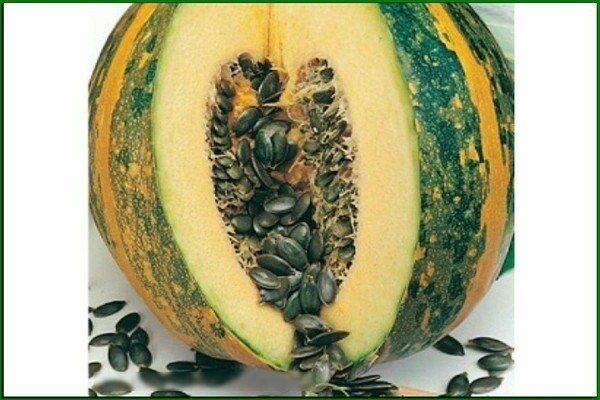

Photo of the Styrian gymnospermous pumpkin variety
This variety of gymnospermous pumpkin originated in Austria, in the province of Styria. The seeds of the Styrian gymnospermous pumpkin contain a lot of oils, which makes this pumpkin quite a valuable variety in the manufacture of pumpkin seed oil. This variety feels pretty good on the territory of Russia. The pulp of such a pumpkin does not contain too much sugar. Has a pleasant aroma with a nutty tone.
This variety belongs to the mid-late varieties in terms of ripening. It sings for about three months. Styrian gourd is quite demanding on heat and light levels. It has long shoots, forms a lot of stems. Pumpkins have a rounded shape, in their mass, as a rule, reach from five to seven kilograms. The color is mostly greenish with light yellow stripes. There are a lot of seeds, they are of medium size and a dark green color. Such a pumpkin can be stored for three months.
Pumpkin Apricot gymnosperm
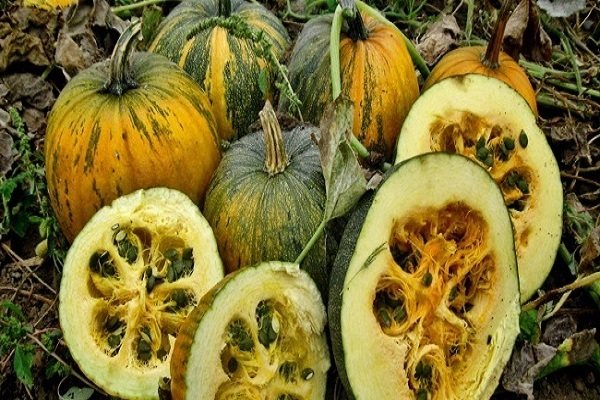

This is a dessert variety, Styrian pumpkin is a direct relative. The appearance of these varieties is quite similar. It has a bright yellow color with greenish lines that run longitudinally. It has a beige pulp and an amazing taste with an apricot hue. The seeds are medium in size and there are quite a few of them. In Soviet times, this pumpkin variety was grown in order to produce apricot juice. In terms of ripening, it belongs to medium-late varieties. Forms a lot of shoots. One fruit in its weight reaches about eight kilograms.
Golosemyanka
This pumpkin is quite similar in biological properties to other Austrian varieties. This plant is bushy, thrives in temperate climates. It is a technical variety that is usually planted to produce oil. This variety is one of the first representatives of gymnospermous pumpkin in our country. This variety belongs to the mid-late varieties in terms of ripening. The biological maturity of such pumpkins occurs in one hundred and ten days. This variety does not form too many shoots, they have a branched shape, reaching about three to four meters in length. In the upper part, as well as closer to the base, the pumpkin is slightly flattened. Usually the fruit is yellow and green in color. If the plants do not receive enough light, then the green color predominates. The inside of the pumpkin is light yellow in color, the texture is not too fibrous. In terms of taste, this pumpkin is quite neutral, a little with a sweetish aftertaste.This variety has a fairly large number of seeds that have a dark grayish color.
Pumpkin Danae gymnospermous
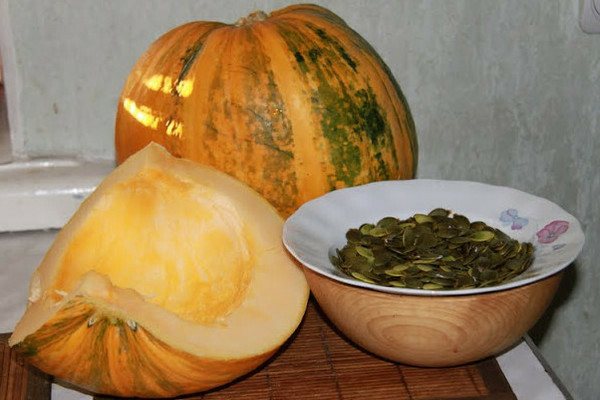

This type of gymnospermous pumpkin is very popular in the middle lane. This is a technical pumpkin variety. Has a good level of resistance to low temperatures. In terms of ripening, this variety belongs to the middle-late varieties. Full maturity occurs after about one hundred and twenty days. The bush is rather strongly branched. Shoot formation is average. The fruit has a rounded shape, dark green color, mesh patterns are present. Inside, such a pumpkin has a light yellow tint. There is no sweetness as such, rather large fibers. Seeds in large quantities are good for making pumpkin seed oil.
Olga
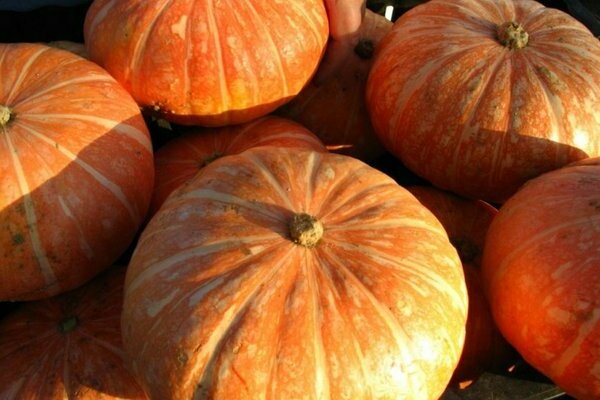

In terms of ripening, this pumpkin belongs to an early-ripening variety. It is a table variety. It grows in the form of a semi-shrub, a fairly compact plant in size, the shoots are not too long. The fruits usually ripen at the same time. The fruits are even, in their weight they reach from one and a half to three kilograms. The surface of the rind is rather rough. Orange color. The seeds of such a pumpkin are not large, they have a light greenish color. There are not too many of them.
Juno
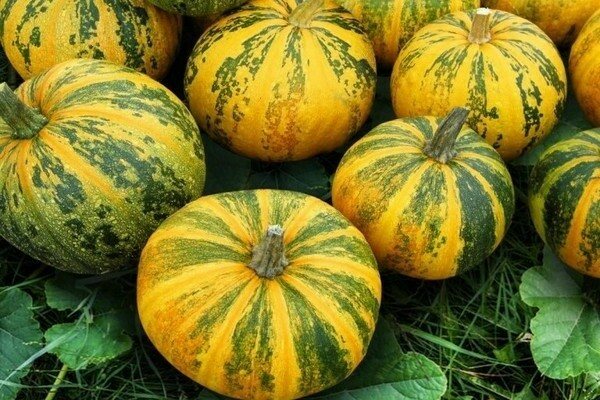

This pumpkin variety belongs to the early ripening variety in terms of ripening. The fruit is able to ripen in ninety days. This variety is quite unpretentious to care for. It has a spreading shape, lateral stems grow rather actively. It is impossible to allow thickening and too close distance between plants in the cultivation of gymnospermous pumpkin. The shrub must be pruned periodically. Very good yield results. The shape of the fruit is quite even, in its weight it usually reaches about eight kilograms. The seeds are dark in color. Their number is high.
Miranda
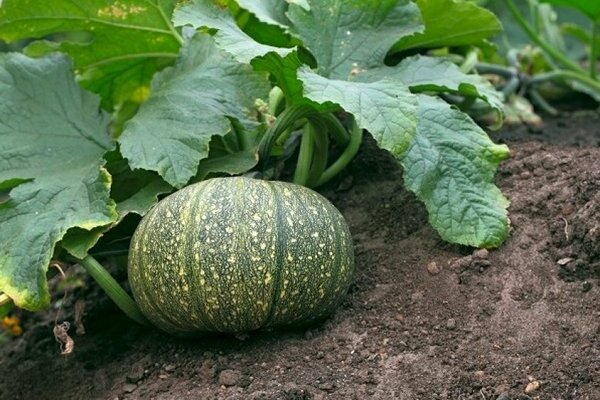

This gymnosperm pumpkin variety appeared thanks to breeders from Poland. The plant belongs to semi-shrubs, not too high in height. It does not have spreading stems, it is rather compact. The variety belongs to medium late, ripening occurs in one hundred five - one hundred and ten days. It does not form too many shoots. The harvest is abundant enough.
This pumpkin variety is a table pumpkin. The fruit has a rounded shape, slightly flattened. At first, the fruit is green in color, and with the onset of maturity it acquires a grayish tint. One fruit usually weighs between five and eight kilograms. Inside the pumpkin has a lot of juice, the thickness of the pulp is about seven centimeters. It contains a lot of sugars and starch. There are not too many seeds, they have a light greenish color.
Eso
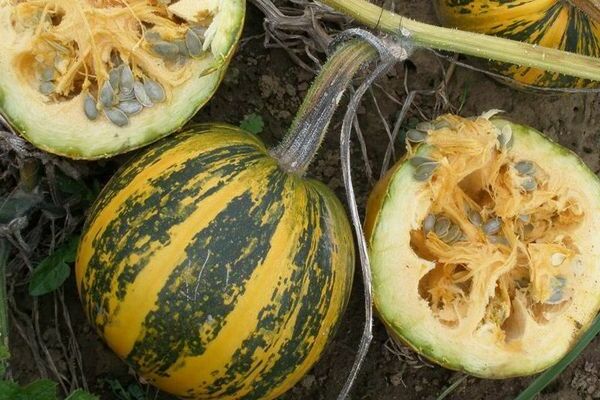

This variety was developed in the Czech Republic. This is a fairly popular company for the supply of seeds to the European market. Eso was taken out for cultivation on an industrial scale. Feels good in a variety of weather conditions. In terms of ripening, this variety belongs to the mid-season. It usually takes about one hundred and ten days before harvesting. The plant grows quite strongly in the garden. This variety is intended in order to obtain seeds. On the inside, the pumpkin has a fairly neutral flavor. The pulp is not too thick, has a light yellowish tint. The fruit is round and dark green in color. It usually weighs about nine kilograms. The skin is rather coarse, not thick. Such a fruit is stored for no more than one and a half months. After the harvest is harvested, the pumpkins are immediately processed.
Reviews of gardeners
The naked gourd is controversial. Some gardeners do not like it, because they believe that the main thing in the pumpkin is the pulp, not the seeds. However, many farmers are willing to argue with them.
Alexander, Rostov-on-Don: “I love trying unusual vegetables on my site. I decided to plant the variety Golosemyannaya 14 and was not disappointed.Although the vegetable does not look like a pumpkin in the conventional sense, I was pleased with the harvest. I put some of them into blanks, and some I ate fresh. The green seeds also tasted great. I baked bread and cupcakes with them for tea. "
Maria, Ufa: “My favorites are nutmeg and gymnosperms. I especially love pumpkins Olga. They don't come out that big, so they're easy to use in the kitchen. And in my opinion, this variety requires a minimum of attention. "
Valeria, Orsk: “I planted the Danae variety once. The manufacturer promised a dense pulp and a large number of seeds. The result is fibrous, semi-empty vegetables. I think this is a manufacturing defect, but there is no desire to try Danae anymore. "
Gymnosperm pumpkin: photo, growing rules
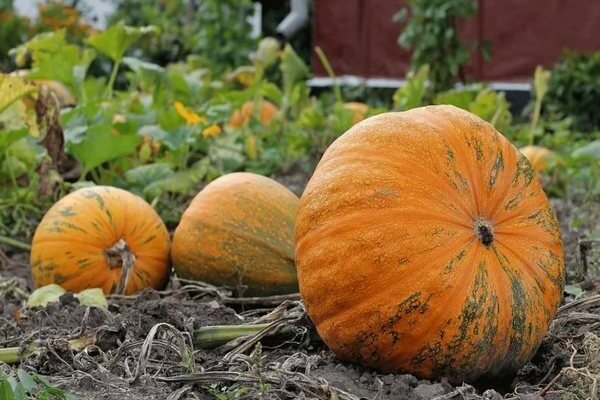

Gymnosperm pumpkin: photo, growing rules
This culture is quite demanding on the presence of light. For planting, it is better to choose well-lit areas of land. Such a bed should be protected from winds and drafts. An elevated area with a southern exposure is well suited. Gymnosperms pumpkins are bad for drought; plants need regular watering for normal development. Rhizomes are located in the surface layer of the earth. For this reason, waterlogging the soil is also dangerous. So, the root system can become infected with fungal diseases.
As for the composition of the soil, it will be better if it has a neutral or slightly alkaline pH reaction. Sour soil is not suitable for growing these varieties of pumpkin. The structure of the soil should be light enough, air and moisture should pass well into the ground. The composition of the soil must have a sufficient amount of nutrients. This parameter can be adjusted by applying fertilizers, as well as by observing crop rotation. You shouldn't grow pumpkin in the same garden for more than three years. Melon plants are bad precursors for pumpkin.
Do not plant an ordinary pumpkin next to a gymnosperm pumpkin. The fact is that the bushes will be pollinated, and in the next season you will not get the expected result. The site for planting is being prepared in advance. It needs to be dug up, as well as organic fertilizing. Before sowing pumpkins, you need to shed the soil well. When to sow pumpkin seeds, it depends quite a lot on the climatic conditions of growing. In this case, the soil must be warmed up by +17 degrees without fail. In this case, frosts should not return. Planting material germinates, as a rule, after a week. If it so happened that cold temperatures returned at this time, then the seedlings, most likely, will not recover.
In order to properly plant gymnosperms pumpkins, it is necessary to observe some algorithm:
- The seeds must be warmed up for eight hours. The temperature should be no more than forty degrees.
- Then place the seeds in a growth promoter for about five hours. Many experienced gardeners use Vympel for these purposes.
- Landing holes are made about thirty by thirty centimeters. Then pour in one hundred grams of ash solution. Add one hundred grams of potassium sulfate there. This amount of fertilizer is enough for two liters of water.
- Mix five kilograms of humus and one hundred grams of superphosphate. Hold this mixture at the bottom of the planting hole. This layer is usually about fifteen centimeters.
- At a depth of about five centimeters, spread four seeds, the distance between them should be about four centimeters.
- Pour soil on top, lay a layer of mulch. To do this, you can use sawdust or straw.
After the first shoots appear, you need to leave two strong shoots in one hole. Those that remain must be removed.
Sowing seeds in open soil is recommended in areas with a southern climate.For regions with a temperate climate, the seedling method of growing gymnosperms is more suitable. This culture is bad enough for the transplant procedure. For this reason, it is best to use peat cups.
Requirements for soil and crop rotation
Like any pumpkin variety, the gymnosperm is the same thermophilic plant of a short subtropical day. Our latitudes are not too generous with sunny weather, therefore, well-warmed, sheltered from the wind areas, preferably on the southern slopes of the hills, are allocated for this culture.
Soils are required well aerated, rich in organic matter, humus, not lower than slightly acidic (pH from 6.5 to 7.5). More acidic ones inhibit the development of plants. Pumpkin is very nutritious. According to research, the plant consumes 4.5 kg of potassium, 2.7 kg of nitrogen and 1.2 kg of phosphorus from the soil per ton of fruit, with a utilization rate of 50, 50 and 40%, respectively. Of course, such losses cannot be replenished with organic matter alone, so you should take care of a normal crop rotation, as well as regular feeding.
The most successful precursors to pumpkin can be potatoes, corn, cabbage, onions, carrots, beets, and a variety of spicy greens. Re-sowing the site with a similar crop, such as cucumbers, squash, zucchini, watermelons, is permissible no earlier than after 4 years. There are two reasons: there may be pests and diseases common to all melons from the last season, as well as a strong depletion of the land that requires replenishment.
Gymnosperm pumpkin: growing, planting seedlings
- Sowing seeds should be based on weather conditions. Seedlings can usually be replanted after thirty days.
- You need to put soil in the cups. Typically, this mixture includes compost, peat and a layer of soil on top. The proportions are equal.
- The planting depth of pumpkin seeds is approximately four centimeters.
- The cultivation of this culture for seedlings occurs at +22 degrees. In this case, the illumination level must be maintained sixteen hours a day.
- When the first leaves of the plant appear, then it is necessary to add top dressing. For example, Uniflor growth.
Temper your seedlings before replanting plants to their permanent habitat. To do this, for several days, you need to take out the seedlings to an open area.
When planting, you need to follow a certain pattern, there should be seventy centimeters between the rows. If you have chosen a bush pumpkin variety, then the distance between the bushes should be about sixty-five centimeters. If the variety is medium-sized, then one and a half meters. And if you gave your preference to fairly tall plants, in which the stems grow actively, then there should be at least two meters between the plants.
How to properly care for a gymnosperm pumpkin? First, you need to water the plants every day. For this, it is better to choose the evening time. Secondly, as necessary, you need to weed and loosen your plantings. Thirdly, periodically you need to feed your pumpkin plantings. Often used for this are Azofoska, Uniflor-micro. Also pumpkin responds very well to organic feeding. Fourthly, it is necessary to remove the stems growing on the side in time. One plant leaves from four to seven ovaries. This depends on which pumpkin variety you choose. The upper parts of the plant need to be broken.
As the pumpkins begin to ripen, place the fruits on the prepared straw layer. This must be done so that the fruits do not have contact with the soil. For this purpose, supports are sometimes used.
About pests and diseases of gymnospermous pumpkin
Gymnosperm pumpkin, thanks to the painstaking work of breeders from all over the world, has a high level of resistance to various diseases and pests. However, pumpkin is sometimes attacked by powdery mildew and anthracnose.
Powdery mildew - a fungal disease manifested by gray spots on the leaves. The reason is excess nitrogen, lack of moisture, cold damp weather. Control methods: Powdery mildew appears due to fungal infections. With this disease, gray spots appear on the plants. This is due to too much nitrogen. Powdery mildew can also appear with insufficient moisture. And also if the weather is too humid. First you need to remove the parts of the plant on which the powdery mildew symptom is present. Then, using preparations based on colloidal sulfur or sodium phosphate, treat your plantings. Sometimes gardeners use Topaz or Universal Dew. Anthracnose appears on plants as dark yellowish spots. Then they become larger and take on a dark pink color. Such a fungal disease destroys the entire bush. These pumpkins are not suitable for human consumption. If the pumpkin has picked up anthracnose, then it will not be cured. It is necessary to remove the infected plant from the garden as soon as possible. In order for such an attack not to climb onto your site, you need to observe the crop rotation of crops, before planting gymnospermous pumpkin, disinfect the planting material with drugs directed against fungi. Before planting plants in the garden, treat the soil with fungicides. After harvesting, it is necessary to completely remove plant residues from the ground. If your landing is attacked aphid, then Fitoverm or Iskra will help get rid of it. From caterpillars whitefly the drug Commander helps.
The risk of overdusting
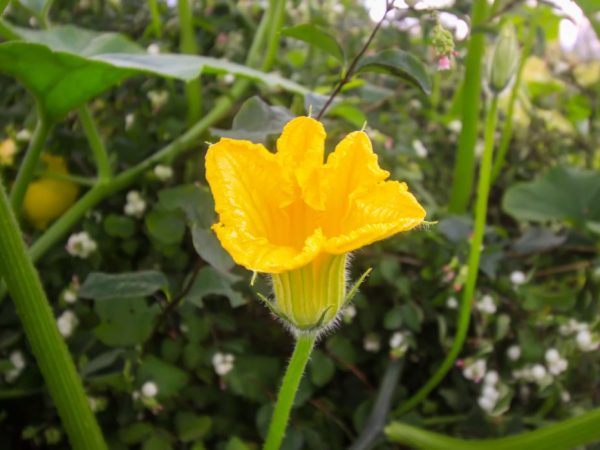

The variety is prone to over-pollination
According to the description of gymnospermous pumpkin, one of its features is a tendency to over-pollination. This is especially undesirable if the crop is grown for subsequent seed production.
The bottom line is that the sowing material collected from such a crop loses its varietal identity the next year: vegetables will combine the characteristics of the main variety and pollinating plants.
Gymnospermous pumpkin forms the ovary with the help of insects, the range of which is quite large. If other melons and pumpkin crops grow near the garden bed, the threat of cross-pollination increases several times.
To avoid this, pollination is carried out manually. Using a soft brush, pollen is transferred from a male flower to a female one. To restrict further access of insects to the peduncle, it is isolated (placed in a plastic bag, cloth or gauze bag, tightened the top of the flower with an elastic band).
The procedure is repeated several times. This not only increases the chances of maintaining the varietal identity of the crop, but also increases the yield indicators.

